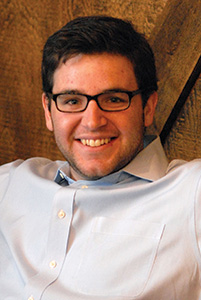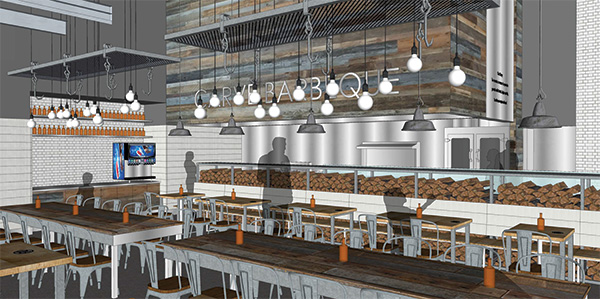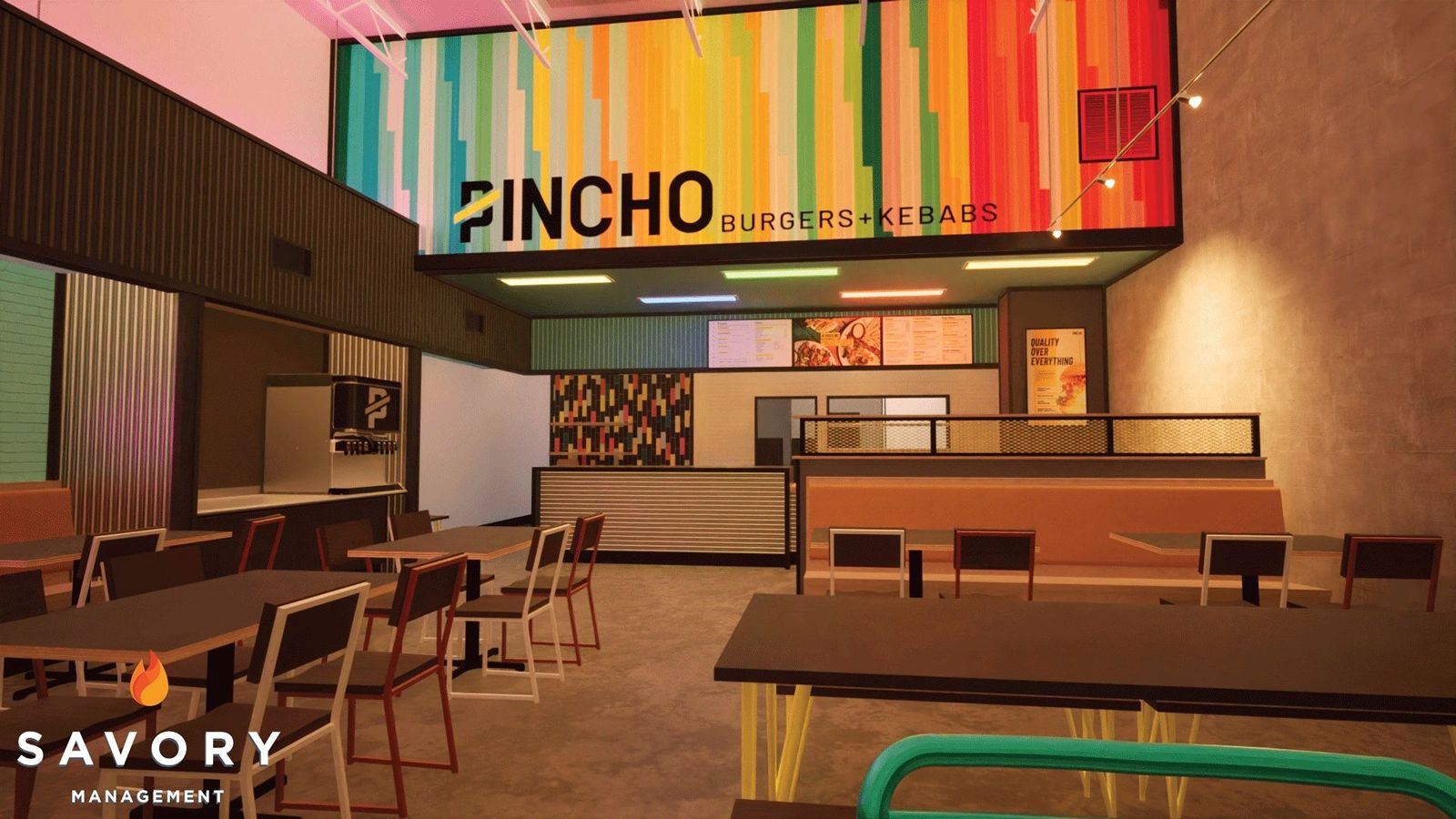Intent on carving out a slice of the fast-casual market, Southern Concepts Restaurant Group (SCRG) will launch its Carve Barbecue concept this September. SCRG is a publicly traded, Colorado Springs–based restaurant holding company that licenses the Southern Hospitality restaurant brand in Colorado. The original Southern Hospitality, located in New York City’s Hell’s Kitchen, was founded in 2007 by musician and actor Justin Timberlake with friends Eytan Sugarman and Trace Ayala.
Having exported the full-service, Memphis-style barbecue brand to three Colorado locations, the three-year-old SCRG has shifted its focus to its new fast-casual iteration. In 2013, it brought on former investment banker Mitchell Roth, Co-Chair & CEO to lead the drive. He recently shared SCRG’s development strategy and a few Carve Barbecue design highlights.
 Mitchell Roth, Co-Chair & CEO, SCRGrd+d: Investment banking guy now leads a start-up fast-casual restaurant brand with aggressive growth plans. How’d that happen?
Mitchell Roth, Co-Chair & CEO, SCRGrd+d: Investment banking guy now leads a start-up fast-casual restaurant brand with aggressive growth plans. How’d that happen?
MR: That’s right. My background isn’t in the restaurant business, but this opportunity came up about a year and a half ago, and it’s very exciting. As a public company, it’s important to have someone at the helm who knows the financial and regulatory side of things, so my investment banking background is a good fit. At the same time, I’m very passionate about the restaurant business from the consumer point of view. I was able to look at the company with fresh eyes, analyze best practices and help identify the strongest opportunities for future growth.
rd+d: That analysis led you to steer away from full-service and toward fast-casual?
MR: Our full-service restaurants are doing well, and we’ll continue to operate them. But fast-casual has been the fastest-growing segment of the industry for the past several years, far outpacing QSR and traditional casual dining. We saw an opportunity to take the expertise we had developed in barbecue at Southern Hospitality and create our own fast-casual concept. We wanted something that would be more scalable, enabling us to grow more quickly and generate greater shareholder value. We expect the first Carve unit to open in September in Denver.
rd+d: Besides service format, how does Carve differ from the original Southern Hospitality?
MR: Guests will see much more of the food prepared in front of them, and there will be a lot more opportunities for customization. The menu is more limited in terms of the number of items featured, but those items can be customized in literally thousands of different ways. All of our meats are smoked on-site and carved to order at the carving station. They can be ordered in four different ways — naked, which is traditional barbecue plated with choice of side; as a salad; a sandwich; or in street tacos, which we also do at Southern Hospitality and which are really popular. From there, you move on to garnishes, which range from pickles and onions to cucumbers, tomatoes, cheese, sweet and hot peppers, etc. Side dish options include coleslaw, potatoes, baked beans with burnt ends, steamed vegetables and fresh fruit. So there are a lot of options for creating meals that are either very traditional or quite nontraditional, depending on guests’ tastes and dietary preferences.
rd+d: What do you see as your main differentiators?
MR: On the menu, we’re doing a lot of things to differentiate Carve from barbecue chains in the QSR space. In particular, we’re working with premium vendors for everything from soda, iced tea and beer, which are all craft-focused, to proteins, which are all-natural, humanely raised and very high quality. We’re also offering plenty of options for healthy dining, which often isn’t the case in the barbecue segment. And we’re launching with a prototype that’s very Millennial-friendly, sustainable and distinct in look and feel from traditional barbecue places with pigs in the logo and dark, pit-style interiors. We have an open kitchen, and we rub, smoke and trim all of our meats on-site in a very visible fashion. We even have a window into one of our coolers so customers can see all the action. It’s very transparent and the design was strategically conceived to highlight the quality of the food.
rd+d: What kind of appearance was SCRG going for with Carve Barbecue?
MR: We worked with Roth Sheppard Architects, a Denver-based firm that has worked with some very successful Colorado-based fast-casual chains. They did a phenomenal job and really understand consumer preferences, particularly in that 24- to 39-year-old range, which is a target group for us. We went with a lot of reclaimed barn wood, light grays and blues, whitewashed wood paneling and track lighting. We’re also using a lot of stainless steel, which is durable but gives a nice, clean look. Our furniture was manufactured by a local firm largely from repurposed materials. Overall, it’s very much a modern, fresh, hip and open feel created with rustic and industrial materials.
 Carve prototyperd+d: What impact does Carve’s high-quality proteins, craft beverages and elevated design have on check averages relative to other fast-casual competitors?
Carve prototyperd+d: What impact does Carve’s high-quality proteins, craft beverages and elevated design have on check averages relative to other fast-casual competitors?
MR: We will push the envelope a bit relative to guys like Chipotle, but there are other fast-casuals out there who also are redefining what the $10 lunch can be. We’ll come in around $12 on average. The quality of the product will stand on its own, and that’s really what is driving the emerging fine-fast-casual market right now. Consumers are willing to pay more for it. At the same time, we know we have to keep the venue and the price affordable to encourage multiple visits a week. You can’t let price get away from you, and you still have to provide options that let people get a substantial meal for eight bucks. We do. We also will see a lot of checks for $30 or more for takeout orders. That’s another important aspect of our concept. We promote large, by-the-pound and by-the-quart options for takeout right on our menu boards.
rd+d: Unit No. 1 is just about to open. What comes next? What are the development plans for Carve?
MR: We’re planning to open one more before the end of this year and another four in 2016. Initially, we’ll develop in Denver and the surrounding markets, such as Boulder, Fort Collins and Colorado Springs. Beyond that, we’re looking to grow in the Phoenix and Scottsdale areas. There’s a lot of migration between the Denver area and those markets so we’d already have some brand awareness. Looking even farther out, we’d look for high net worth markets like San Diego and Orange County, Calif. Those are some of the best fast-casual markets in the country, and we think the fact that there is not a native barbecue culture there will allow us to build brand equity more quickly.
rd+d: You’ve said that the biggest challenge to hitting your development targets could be real estate availability. What type of sites are you after?
MR: We’re not willing to settle for anything less than A+ locations that meet 100 percent of our site-selection criteria, so that could be a hurdle. Our prototype calls for urban spaces somewhere around 2,500 square feet, ideally endcaps in high-traffic areas with strong daytime populations. Our first location, on South Colorado Boulevard, represents more than 800,000 cars a day. Our second location, which I can’t disclose yet, has even higher traffic. So we’re looking for areas with dense daytime populations and a high percentage of Millennials living and working nearby. It’s really that group that is driving the volume for fast-casual restaurants, and having good access to them is important to the success that we envision for Carve.



